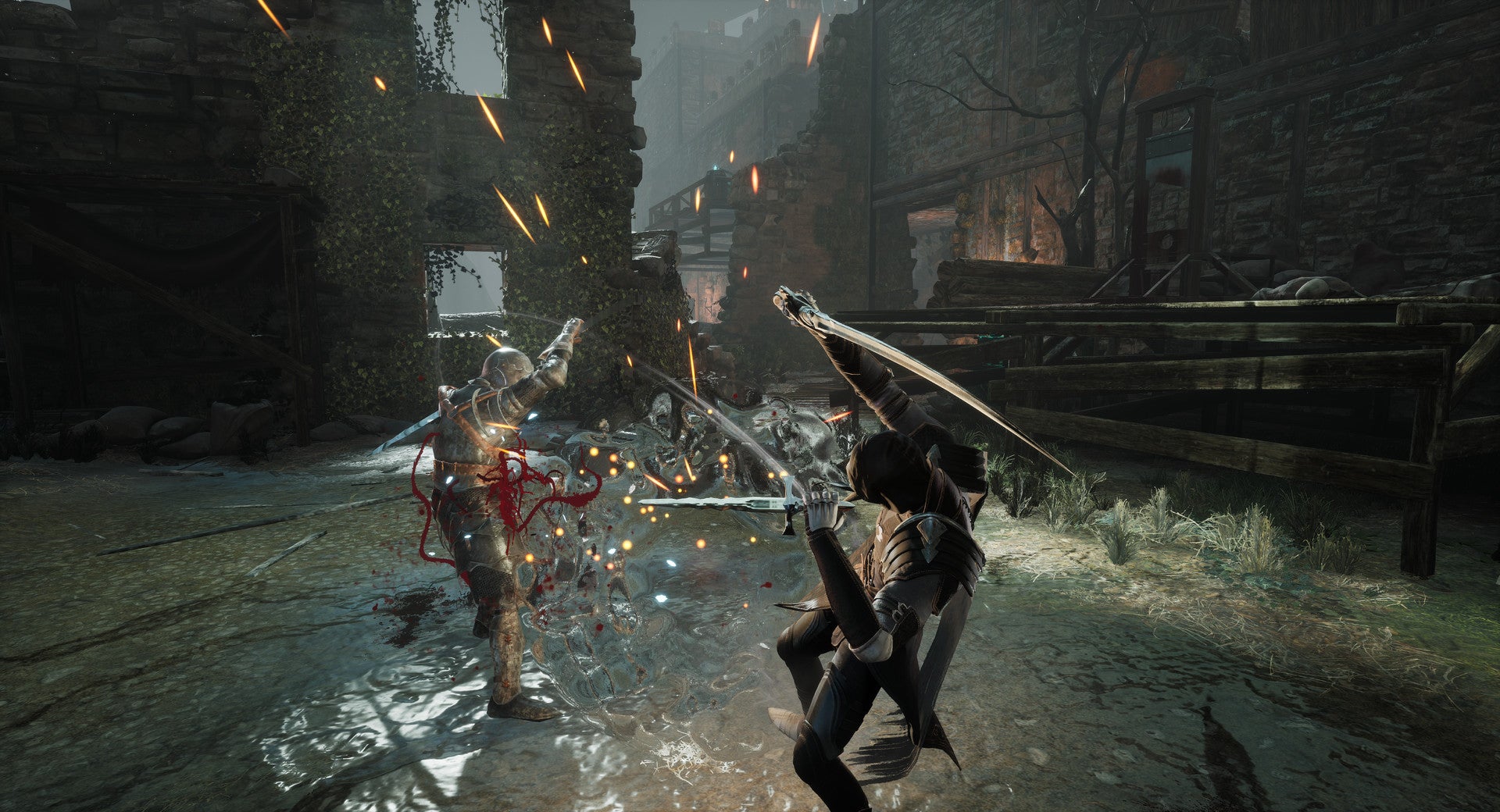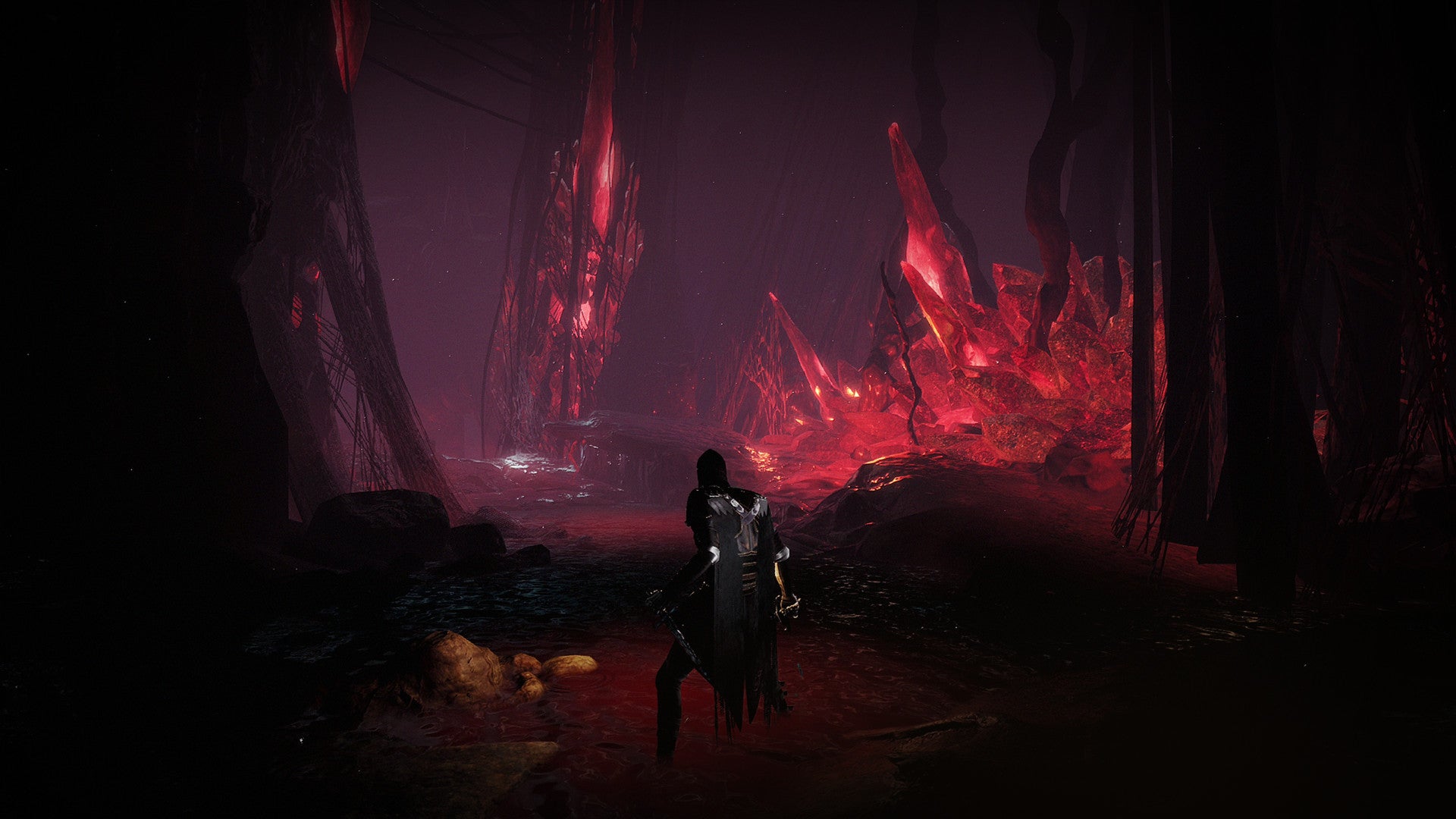Thymesia is a Souls-like action RPG set in a Bloodborne-esque world whose people sought to better their lives through chemistry alchemy. Only, instead of using it sparingly, their unbridled reliance on it left their kingdom in ruins.
You play as Corvus, an amnesiac plague doctor of sorts, who may have had a hand in the creation of a concoction that could save the kingdom, and put an end to experimentation with alchemy. But his memory of the ingredients is shaky, so you go around the game’s three main zones in search of – effectively – lore that helps you piece it all together, and hopefully arrive at the right formula.
Yes, Thymesia only has three main areas. If the story of Bloodborne spanned a large city over generations, it’s best to think of this world as a small town – even if the narrative likes to aggrandise it in a way that isn’t reflected in-game.
After completing the main objective in each location (which ends with a boss fight), side missions are unlocked that take place in the same area. The number of these vary, and you typically only see them pop up after the previous one is done. Think of the way Nioh handles non-essential missions, and you’re in the right ball park.
These side quests use up the same general location, but their layouts are adjusted somewhat; blocking off certain sections, and opening up others. This is part of why the level design in Thymesia is its worst quality: your first time around, you’ll come across locked doors and blocked off areas you’d think can be unlocked through normal progression, but many only do in side quests. This will have you running around a level you’ve entirely cleared of enemies just to find how to get past a locked gate or reach a higher storey.
The lighting in most levels makes this a chore. I’ve missed ladders and open hatches on countless occasions even as I repeatedly ran past them, only to later catch them at a weird angle and figure out they are what I needed to push forward. A simple lantern by the foot of ladders, or really any kind of preferential lighting that makes them stand out from the background would help tremendously.
Enemy visibility is another casualty of the lighting engine. It’s harder to detect enemies than in many of Thymesia’s genre contemporaries. It doesn’t help that the game is a little too fond of setting traps to force you into fights with multiple enemies. My solution was to simply spam lock-on to detect enemies I knew are there, but can’t see. That’s no fun.
It’s not all the fault of how these levels are lit, either: the layouts themselves feel manufactured, too game-y. Where, in Elden Ring, a dungeon flows naturally from one distinct room to a hallway to an open plaza, Thymesia’s levels feel like textured blueprints that do little to communicate character.
The third location, in particular – set in a castle – is a nightmare to navigate. It’s an interconnected maze of several floors and an underground area that all link up through stairs, ladders, locked gates, and good ol’ drops. Because the layout never makes sense, I spent most of time simply using enemies as a sort of compass: if I see one, I know I’ve not been to that part of the level. The lack of any sort of map, or item you can use to mark off areas, makes this all the more frustrating.
The star of the show is Thymesia’s combat. Though flawed, it is the most polished and often impressive part of it. This is an action game at heart, doing away with stamina-based limitations altogether. You can run, dodge, and attack as often as you want without worrying about using up a stamina pool.
The main hook to the combat is the Plague mechanic. With every hit to an enemy, you wound them. This depletes their white health bar to reveal a green bar underneath. If you don’t stay on the offensive, wounds will heal and the green will slowly turn into white. But to deal damage to the green bar, you need to use your Claw. Claw attacks can deal standard damage, but they’re best at capitalising on Plague damage instead.
You can invest in upgrades that boost the Plague damage your strikes deal to enemies, and delay their regeneration. That system is unique, and suggests a sort of back-and-forth style of fighting that mechanics sadly don’t make good on in practice.
A more cautious player will effectively have to contend with two health bars for every enemy. This is especially true for bosses, whose already gigantic health pools feel ever more daunting as you see them regenerating HP while you try to avoid their long attack chains.
In Bloodborne, the FromSoft game Thymesia is chiefly inspired by, the player is incentivised to stay aggressive by being rewarded some of their lost health back if they manage to land a hit on an enemy quickly after taking damage. The same is not true for enemies, however, giving players a clear advantage.
The reverse is true in Thymesia. The Plague mechanic only works in the enemies’ favour. The health you lose cannot be regained, which gives enemies an unnecessary edge. This is exacerbated by the limited offensive options at your disposal.
Your only main weapon is a saber, which has a standard light attack combo. You can’t modify its reach, or increase hit damage through heavy attacks. It cannot be upgraded, either, meaning you’re always limited by what it can do from beginning to end. Enemy attack chains, however, are often lengthy, with long reach and accurate tracking.
Spamming dodge can help you avoid them, but that lost time is enough for them to regain HP. Even dodging can be risky thanks to the game’s brief invincibility frames. Thymesia’s dodge is a little floaty, too, and you’re going to get hit if you miss-time your dodge even a little. This was apparently a problem in a recent Steam demo, which the developer said will be fixed for launch. I am not clear on whether or not this build of the game includes said fix.
Super-armour, a technique that prevents enemies’ attacks from being interrupted by your own, is also a factor. The existence of that mechanic is fine, of course, but it’s never clear which enemies and which attacks come with super-armour, and that can make boss fights frustrating when you don’t know which moves are safe to punish.
Other games communicate this interplay through the type of armour the enemy is wearing, and the class of weapon you happen to be using. But deducing this dynamic is impossible in Thymesia, so you’re instead left to rely on trial and error. The game does have a limited number of enemies anyway, so that won’t be a problem down the line.
The developer clearly wanted players to rely on Plague Weapons, which are essentially magic attacks that use up Energy (green pool that’s basically mana). The more you run into enemies, the more of their Plague Weapons they’ll use against you, and that’s really where the build diversity comes into play.
There are nearly two-dozen of these to discover, and they can be upgraded by earning Shards from defeated enemies wielding each one. Later into the game, it becomes almost a necessity to open up with a Plague attack. By investing into shortening their cooldowns and widening the Energy pool, they can effectively turn into your main tool rather than an ancillary.
This does make up for the shortcomings of the main saber attacks somewhat, but it can trivialise the challenge and eat away at the diversity the game has. I never really found a reason to deviate from my loadout of a heavy stun-inducing Plague Weapon, and a ranged option to poke from a distance.
The final component of combat is parrying, but its implementation is likewise puzzling. By timing your block to catch the enemy’s weapon just before it hits you, you can parry. But don’t expect this to stagger the enemy and open them up for a riposte.
What happens instead is that some of their attack damage is transferred back to them, but they’ll continue their chain like nothing happened. There’s a faint, but recognisable audio cue that accompanies a parry, but you’ll quickly realise it’s not worth figuring out the timing or listening for that cue. Dodging is a much safer and guaranteed way of avoiding damage.
Certain enemy attacks are perilous, and can either be avoided entirely or interrupted with a feather throw. Like parrying, you need to time this correctly. Unfortunately, this is yet another underbaked mechanic you’ll quickly abandon. The window you’re given to punish after a successful interruption is simply too narrow to be effective. It’s so short, in fact, it will likely be over by the time you get closer to the staggered enemy, particularly if you interrupted a ranged attack.
Outside the different Plague Weapons you can find, Thymesia does a fair job at offering diverse builds. Every time you level up, you gain a Talent point, which can be spent on unlocking new moves, enhancing existing ones, or adding new variations to them. The number of points is capped, so you will not be able to acquire everything. Some paths also lock you out of others. For instance, you can widen the parry window and decrease its effect, or shorten it and make it more effective. You can freely re-spec the entire tree or individual Talents at any time, too.
So much of Thymesia feels like an under-budget first game from a new studio. Setting aside the surprisingly small number of locations and limited enemy variety, certain aspects are curiously under-funded. There’s no voice acting in the game whatsoever, despite there being cut-scenes, and several boss quotes.
Dialogue lines are so few, in fact, that I assumed voice acting would be added ahead of launch. Publisher Team17, however, confirmed to VG247 that there are no plans to add voice acting. I don’t like to speculate the hows and whys, but this level of production value is bound to make a poor first impression.
You can see the make-up of a good game at the heart of Thymesia, but it seems the team was only capable of delivering a prototype; the building blocks of something greater, before it tapped out. You can easily spend ten-ish hours with the game, and potentially longer if you decide to experiment with builds, but at $25 (or $22.49 with the launch week discount), it might be a hard sell.
Version tested: PC. Code provided by publisher. Also available on PS5, and Xbox Series X/S, and Switch Cloud on August 18.


